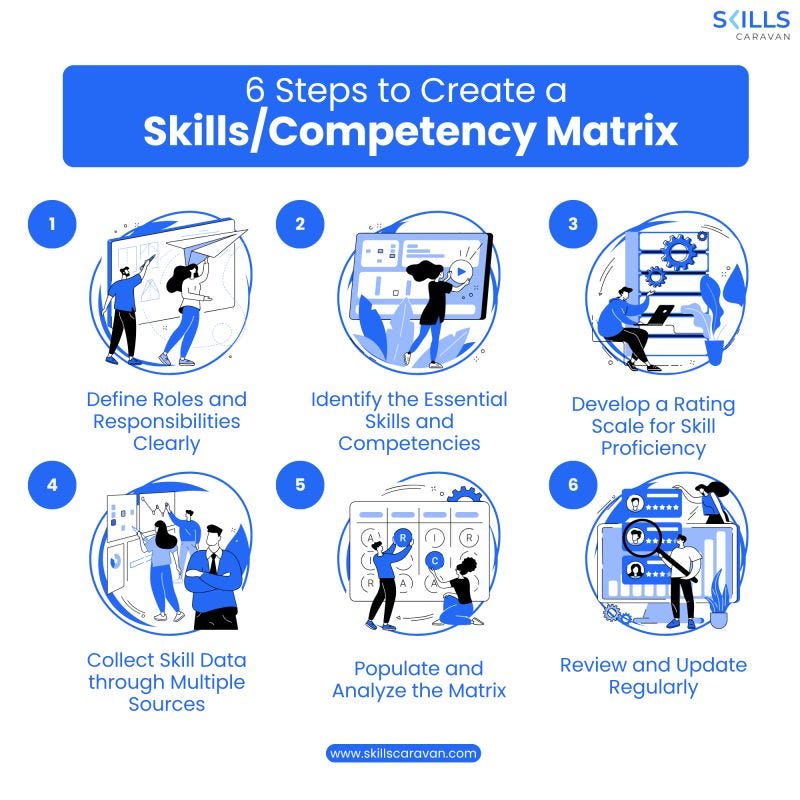How to Create a Skills Matrix With the Help of AI?
In today’s fast-changing business landscape, organizations must stay agile to remain competitive. One effective way to achieve this is by mapping and managing employee skills through a skills matrix. But doing this manually can be time-consuming and error-prone. That’s where artificial intelligence (AI) comes in.
In this blog, we’ll explore how to create a skills matrix with the help of AI, step by step. We’ll also look at the benefits of using AI tools to automate, analyze, and continuously update your skills data.

✅ What is a Skills Matrix?
A skills matrix is a visual tool (usually a table or grid) that maps employees’ skills against required competencies for their roles or projects. It helps HR teams, managers, and learning & development (L&D) professionals to:
- Identify skill gaps
- Plan targeted training
- Optimize resource allocation
- Support succession planning
- Improve team performance
Traditionally, creating and maintaining a skills matrix meant endless spreadsheets and manual data entry. But now, AI can revolutionize this process.
🤖 Why Use AI to Build a Skills Matrix?
Before we dive into how to create a skills matrix with the help of AI, let’s see why AI makes a real difference:
- Automated data collection: AI can extract skills data from resumes, LinkedIn profiles, performance reviews, learning systems, and project records.
- Dynamic updates: Instead of static spreadsheets, AI systems can continuously refresh skills data as employees complete new courses or gain certifications.
- Advanced analytics: AI tools can identify hidden skill gaps, predict future skills needs, and recommend personalized training plans.
- Better visualization: AI-driven dashboards can transform raw data into interactive visual skills matrices, making insights clear and actionable.
🛠 Step-by-Step: How to Create a Skills Matrix With the Help of AI?
1️⃣ Define Objectives and Scope
Start by clarifying why you need a skills matrix. Is it for a specific project, department, or organization-wide initiative? Define the scope, the roles to include, and the competencies that matter most to your business goals.
For example, if your goal is to support digital transformation, focus on technical skills like data analysis, AI literacy, or cybersecurity, as well as soft skills like adaptability and collaboration.
2️⃣ Choose the Right AI Tool
There are many AI-powered HR and L&D platforms that can help create a skills matrix. Some popular examples include:
- LinkedIn Talent Insights
- Degreed
- Eightfold
- Gloat
- Cornerstone
Look for tools that integrate with your existing HRIS, LMS, or talent management systems. Prioritize features like:
- AI skill detection
- Customizable competency frameworks
- Dashboards and reporting
- Recommendations for learning content
3️⃣ Collect and Enrich Skills Data
This is where AI does the heavy lifting. AI tools can scan:
- Resumes and CVs
- Employee profiles on HR systems
- Certifications and badges from LMS
- Past project documentation
- External professional profiles (e.g., LinkedIn)
Using natural language processing (NLP), AI identifies relevant skills, even when worded differently. For example, it can recognize that “Excel VBA” and “Excel macros” belong to the same skill cluster.
4️⃣ Map Employees to Skills and Proficiency Levels
AI tools often assign proficiency levels based on historical data, certifications, or manager assessments. For instance:
- Beginner
- Intermediate
- Advanced
- Expert
This step builds the core of your skills matrix: a grid showing employees vs. skills and their respective proficiency.
5️⃣ Visualize the Skills Matrix
With AI-powered dashboards, you can create visual skills matrices that are easier to read than spreadsheets. You might see:
- Heat maps of team competencies
- Graphs highlighting skill gaps
- Role-based or project-based skills views
These visuals help managers quickly spot strengths and weaknesses across teams.
6️⃣ Analyze Gaps and Recommend Learning Paths
One of the best things about using AI in a skills matrix is analytics. AI can:
- Compare current skills vs. required skills for roles or projects
- Highlight critical gaps that need urgent attentionRecommend personalized courses, microlearning content, or mentoring opportunities
For example, if a new project needs Python expertise and your team is mostly at beginner level, AI can suggest training plans to close the gap.
7️⃣ Continuously Update and Refine
Skills aren’t static. As employees learn and grow, your skills matrix should evolve too. AI helps by:
- Tracking course completions and certifications
- Updating proficiency levels automatically
- Providing trend analysis over time (e.g., growth in AI skills)
Set a cadence for reviewing your AI-generated skills matrix — monthly, quarterly, or before starting new projects.
🌟 Benefits of Creating a Skills Matrix With AI
To summarize why you should know how to create a skills matrix with the help of AI:
- Saves time vs. manual tracking
- Improves accuracy and reduces bias
- Enables data-driven decision-making
- Supports employee development with tailored training
- Helps future-proof your workforce
⚡ Tips for Success
- Involve employees: Encourage them to validate and update their skills data.
- Keep it relevant: Focus on skills linked to strategic priorities.
- Combine quantitative data (certifications, courses) with qualitative insights (manager feedback).
- Choose AI tools with strong data privacy and security features.
🧩 Final Thoughts
Learning how to create a skills matrix with the help of AI can transform HR, talent development, and workforce planning. By combining AI’s data processing power with human judgment, organizations can build smarter, more dynamic skills matrices that drive growth.
Don’t let your skills data sit in spreadsheets. Leverage AI to unlock its full potential and make better talent decisions.

Comments
Post a Comment